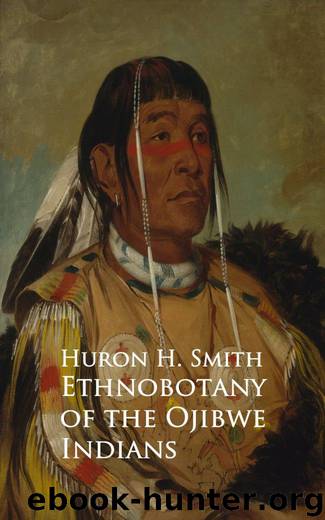Ethnobotany of the Ojibwe Indians by Huron H. Smith

Author:Huron H. Smith [Smith, Huron H.]
Language: eng
Format: epub
Published: 2016-07-30T00:00:00+00:00
Box Elder (Acer negundo L.), “adjagobiˈ mûk”. The Pillager Ojibwe collect the sap of the Box Elder and mix it with the sap of the regular Sugar Maple to drink as a beverage.
Sugar Maple (Acer saccharum Marsh.), “înenaˈ tîg” [Indian tree] and “adjagobiˈ mîn”. Both names came from the Pillager Ojibwe, [127] and although the trees were scarce on the Flambeau Reservation, they also call it “înenaˈ tîg”, and gather quantities of the sap somewhere south of the reservation. Maple sugar is one of their most important foods and is used in almost every kind of cookery. Maple sap is saved to drink as it comes from the tree, sometimes with the added sap of the Box Elder or Yellow Birch. Again it is allowed to become sour to make a vinegar “cîwaˈbo” used in their cookery of venison, which, when afterwards sweetened with maple sugar, corresponds to the German fashion of sweet-sour meat. Before they had the salt of the white man, maple sugar took its place and still does when they can get it. All kinds of meats were seasoned with it. There are many interesting legends about the tree, its discovery and sugar making, as related in Mr. Alanson Skinner’s “Material Culture of the Menomini”. [128] The Ojibwe garner their sugar crop much the same way as they did years ago, except that they have used large iron kettles since the coming of the white man. The sugar camps are rather permanent affairs, and the framework of the boiling house with its upright poles around the fire place to hold the kettles is left intact. A bark-covered wigwam is used to store the tools of sugar sap gathering, and granulation. Most of the sap vessels and storage vessels are made of birch bark, sewed with boiled basswood fiber or the core of the Jack Pine root. The vessels are rendered waterproof by the application of pitch secured by boiling Jack Pine cones.
In early April, the Ojibwe visit their camps, the men to repair the camps and the storage vats of hollowed logs, and to cut fire wood, the women to see that the sap buckets and mokoks are scrupulously clean and watertight. If some can not be repaired, rolls of birchbark are there to make new ones. The whole family then move to the camp and live in the large wigwam, while they make sugar for a month. During the sap flow, a man can chop holes and set taps into from two to three hundred trees in a day. The first flow of sap is the best, and it gets to be of a rather poor quality by the end of the flow. The Ojibwe will not use the night flow of the sap, which they say is bitter, so they cease collecting an hour before dark. Gathered sap is stored in hollowed basswood log vats, and covered over with birch bark to keep it clean. Boiling in the iron kettles is done much as the white man does it, except that foam is dissipated by stirring with a fresh brush of a spruce branch.
Download
This site does not store any files on its server. We only index and link to content provided by other sites. Please contact the content providers to delete copyright contents if any and email us, we'll remove relevant links or contents immediately.
Evelina by Fanny Burney(26796)
Evelina, Or, the History of a Young Lady's Entrance into the World by Fanny Burney(26232)
Twilight of the Idols With the Antichrist and Ecce Homo by Friedrich Nietzsche(18503)
Pale Blue Dot by Carl Sagan(4912)
The Perks of Being a Wallflower by Stephen Chbosky(4573)
Dune 01 Dune by Frank Herbert(4313)
Double Down (Diary of a Wimpy Kid Book 11) by Jeff Kinney(4207)
Man and His Symbols by Carl Gustav Jung(4069)
Walking by Henry David Thoreau(3894)
Separate Beds by LaVyrle Spencer(3771)
Ficciones by Jorge Luis Borges(3573)
FOUNDATION AND EMPIRE by Isaac Asimov(3551)
The 101 Dalmatians by Dodie Smith(3453)
Mystery at School by Laura Lee Hope(3370)
Anna and the French Kiss by Stephanie Perkins(3318)
120 Days of Sodom by Marquis de Sade(3180)
Some Prefer Nettles by Tanizaki Junichiro(2842)
The Little Prince by Antoine de Saint-Exupéry(2828)
My Ántonia by Willa Cather(2812)
